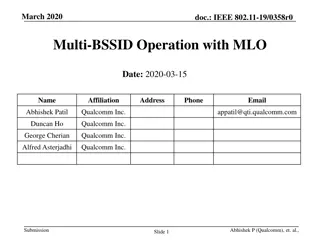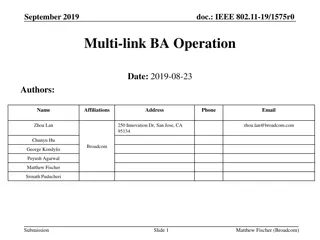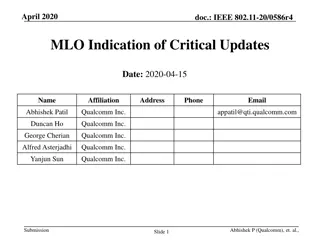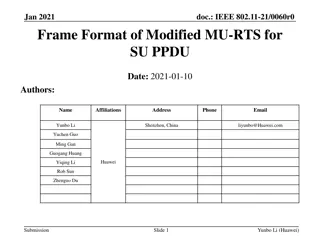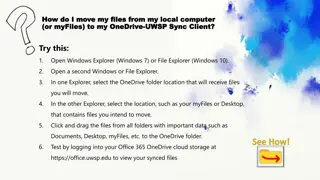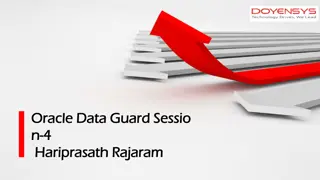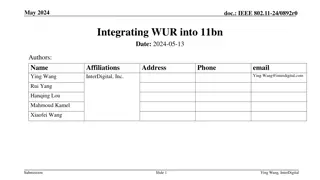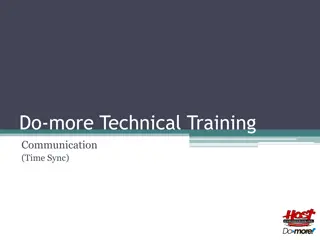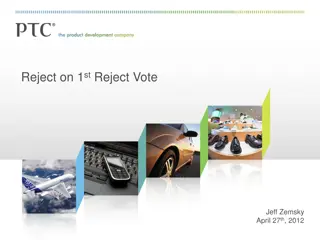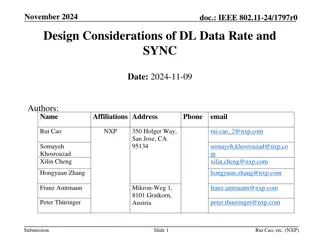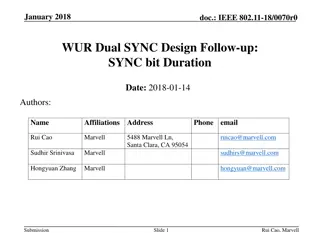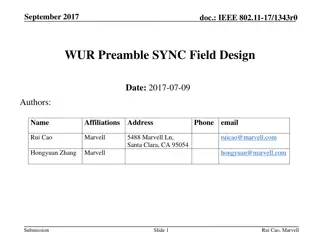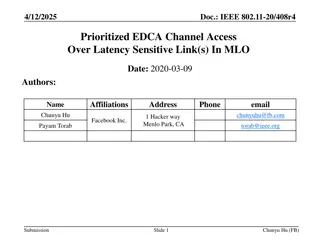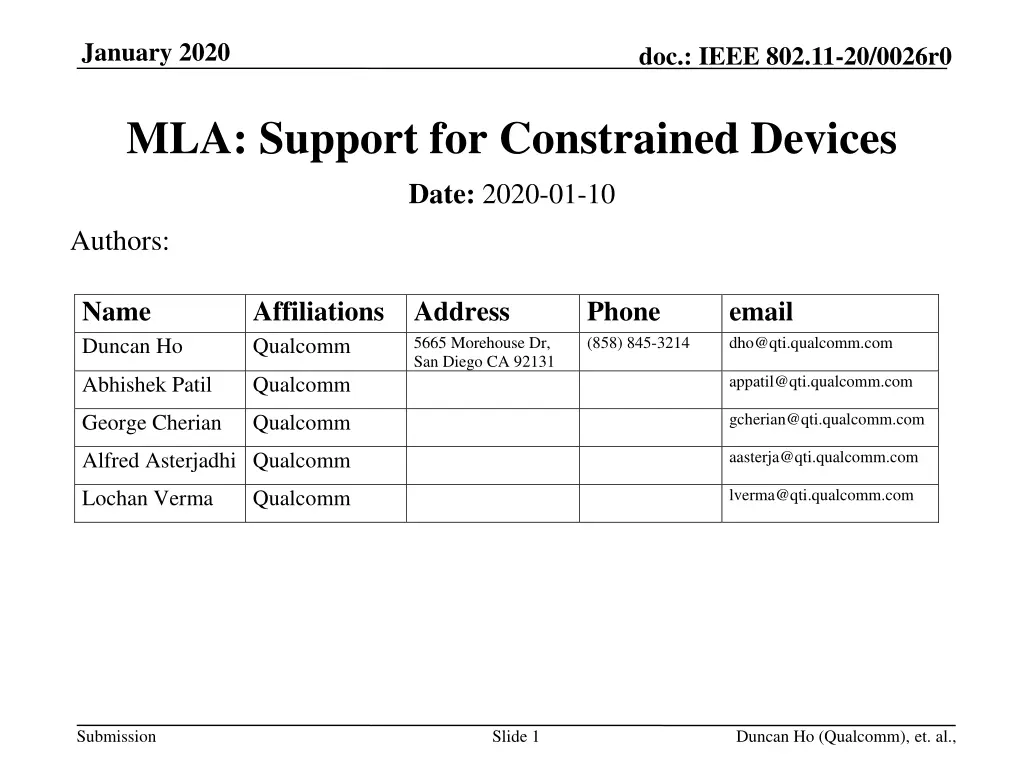
Support for Constrained Devices in IEEE 802.11-20/0026r0 Document
Explore the January 2020 IEEE document discussing support for constrained devices in IEEE 802.11 networks, focusing on topics like simultaneous Tx/Rx capabilities, terminology, background information, proposals for enabling Sync PPDUs, and practical examples.
Download Presentation

Please find below an Image/Link to download the presentation.
The content on the website is provided AS IS for your information and personal use only. It may not be sold, licensed, or shared on other websites without obtaining consent from the author. If you encounter any issues during the download, it is possible that the publisher has removed the file from their server.
You are allowed to download the files provided on this website for personal or commercial use, subject to the condition that they are used lawfully. All files are the property of their respective owners.
The content on the website is provided AS IS for your information and personal use only. It may not be sold, licensed, or shared on other websites without obtaining consent from the author.
E N D
Presentation Transcript
January 2020 doc.: IEEE 802.11-20/0026r0 MLA: Support for Constrained Devices Date: 2020-01-10 Authors: Name Duncan Ho Affiliations Address Qualcomm Phone (858) 845-3214 email dho@qti.qualcomm.com 5665 Morehouse Dr, San Diego CA 92131 appatil@qti.qualcomm.com Abhishek Patil Qualcomm gcherian@qti.qualcomm.com George Cherian Qualcomm aasterja@qti.qualcomm.com Alfred Asterjadhi Qualcomm lverma@qti.qualcomm.com Lochan Verma Qualcomm Submission Slide 1 Duncan Ho (Qualcomm), et. al.,
January 2020 doc.: IEEE 802.11-20/0026r0 Terminology STR (simultaneous Tx and Rx) An MLD that is capable of simultaneous Tx/Rx on multiple links even when the links are near band Non-STR An MLD that is not capable of simultaneous Tx/Rx on multiple links when the links are near band (i.e., it can only do Tx/Tx or Rx/Rx on all links) Submission Slide 2 Duncan Ho (Qualcomm), et. al.,
January 2020 doc.: IEEE 802.11-20/0026r0 Background (1/2) A non-STR MLD cannot use Async mode so Sync mode is preferred However, Sync (Tx/Tx) PPDUs transmission requires tight inter-STA co-ordinations within a Tx MLD E.g., Tx on one link needs to trigger Tx on the other link within a very short time (e.g., within SIFS) to avoid blocking the EDCA of the other link Submission Slide 3 Duncan Ho (Qualcomm), et. al.,
January 2020 doc.: IEEE 802.11-20/0026r0 Background (2/2) For a link to obtain full benefits of MLA in both directions, both peer MLDs of the link should be able to Tx Sync PPDUs However, there are cases where one of the peer MLDs may not support tight inter-STA co-ordinations Is Sync PPDUs currently possible in BOTH directions? AP (tight co-ord.) AP (not tight co-ord) No (case 2) No (case 4) STA (tight co-ord.) STA (not tight co-ord.) Yes (case 1) No (case 3) Submission Slide 4 Duncan Ho (Qualcomm), et. al.,
January 2020 doc.: IEEE 802.11-20/0026r0 Proposal To enable case 2 and case 3, we propose to use ML-RTS to allow Sync PPDUs for cases where at least one of the MLDs is capable of tight inter-STA co-ordinations Use ML-RTS to trigger responses from both receiving STAs of the peer MLD before transmitter the Sync PPDUs Submission Slide 5 Duncan Ho (Qualcomm), et. al.,
January 2020 doc.: IEEE 802.11-20/0026r0 An Example (Case 2) TXOP owner AP sends a an ML-RTS Both STAs responses by a n ML-CTS (if NAV/CCA checks allow) AP1 wins the medium AP ML-RTS (MAC Sync) PPDU (Link1) STA (Link1) ML-CTS BA AP2 checks NAV and CCA before PPDU tx STA1 and STA2 check NAV and CCA on each link and send ML-CTS independently AP2 (Link2) STA (Link2) (MAC Sync) PPDU ML-CTS BA Submission Slide 6 Duncan Ho (Qualcomm), et. al.,
January 2020 doc.: IEEE 802.11-20/0026r0 An Example - Cont d What if STA2 sent ML-CTS but AP2 detects the medium is busy locally? AP2 will not transmit the Sync PPDU on link 2 Receivers of the ML-CTS can use the RTS rules (as if it receives an RTS) to set the NAV so the NAV gets reset if no transmission occurs on link 2 after the ML-CTS (so the medium on link 2 could be used by other STAs) The legacy STAs NAV will still be blocked by the ML-CTS though Alternatively, instead of using ML-CTS, AP1 sends an RTS Poll and the STAs send a regular RTS on each link (with the Duration set to protect the Sync PPDU + BA) Submission Slide 7 Duncan Ho (Qualcomm), et. al.,
January 2020 doc.: IEEE 802.11-20/0026r0 Analysis of Constrained Scenarios STR = Simultaneous Transmission and Reception capable STR AP Not covered (assume Async mode is used) See slide here Non-STR AP Not covered (not likely in practice) STR STA Non-STR STA See slide here Submission Slide 8 Duncan Ho (Qualcomm), et. al.,
January 2020 doc.: IEEE 802.11-20/0026r0 AP: MLD A1 A2 STR AP + Non-STR STA STA: Sa-MLD Multiple Primary channels allowed STA: Sb-MLD S1 S2 Sx Sy S1, A1 & Sx on Link1(L1) S2, A2, & Sy on Link2(L2) Sx, Sy means ANY STAs on L1, L2 STA/AP gets access to L1 UL DL L1+ L2: Sync PPDU (assume tight coupling at STA) L1+L2 : Sync PPDU Use ML-RTS/CTS when AP is loose-coupled L2 is IDLE and PIFS access is allowed on L2 L1: S1 sends PPDU1 to A1 L2: can be used for UL/DL for Sy. No constraints S2 cannot use until PPDU1-end-time o UL: blocked due to CCA o DL: AP may send ML-RTS, but doesn t get response from STA L1: A1 sends PPDU1 to S1 L2: can be used for one of these: UL/DL for Sy. No constraints A2 sends DL for S2, with end-time same as PPDU1. o A2 sends ML-RTS to S2 o S2 sends ML-CTS with PPDU1end-time S2 will not use L2 for UL L2 is IDLE and PIFS access not allowed L2 is BUSY@PPDU1 start, but later became IDLE during PPDU1 Submission Slide 9 Duncan Ho, Qualcomm Incorporated
January 2020 doc.: IEEE 802.11-20/0026r0 AP: MLD Non-STR AP + Non-STR STA A1 A2 Only Single Primary channel Pre-11be STAs operate only on this channel All EDCA access happens only on this channel (including 11be STAs) STA: Sa-MLD STA: Sb-MLD S1 S2 Sx Sy S1, A1 & Sx on Link1(L1) S2, A2, & Sy on Link2(L2) Sx, Sy means ANY STAs on L1, L2 STA/AP gets access to L1 UL L1+ L2: Sync PPDU (assume tight coupling at STA) DL L1+L2 : Sync PPDU Use ML RTS/CTS when AP is loose-coupling L2 is IDLE and PIFS access is allowed on L2 L2 is IDLE and PIFS access not allowed L2 is BUSY@PPDU1 start, but later became IDLE during PPDU1 L2 not usable L2 not usable Submission Slide 10 Duncan Ho, Qualcomm Incorporated

